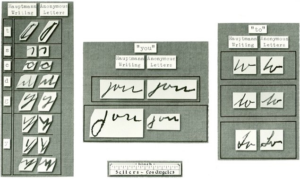
Handwriting analysis falls into the questioned documents section of forensic science. These documents are examined by expert questioned documents examiners or QDEs. QDEs look for forgeries and alterations and make comparisons if there is an original sample of handwriting available.
Handwriting is an individual characteristic. This means that handwriting is unique for each person. Each person has their own style. Handwriting analysts say that people could have a few writing characteristics that are the same but the likelihood of having any more than that is impossible. The similarity in handwriting would be due to the style characteristics that we were taught when we were learning handwriting in school out of a book. Thus, handwriting is as unique as a fingerprint.
Handwriting analysis is looking for small differences between the writing of a sample where the writer is known and a writing sample where the writer is unknown. Instead of beginning to look for similarities in the handwriting, a QDE begins to search for differences since it’s the differences that determine if the document is a forgery. A QDE is looking at three things: letter form, line form, and formatting.
•Letter form– This includes curves, slants, the proportional size of letters (relationship between the size of short and tall letters and between the height and width of a single letter), the slope of writing, and the use and appearance of connecting lines (links) between letters. A person may form a letter differently depending on where the letter falls in a word – beginning, middle, or end. So an analyst will try to find examples of each letter in each placement.
•Line form– This includes how smooth and dark the lines are, which indicates how much pressure the writer applies while writing and the speed of the writing.
•Formatting– This includes the spacing between letters, the spacing between words, the placement of words on a line, and the margins a writer leaves empty on a page. It also considers spacing between lines — in other words, do strokes from words on one line intersect with strokes in words on the line below and above it?
Content, such as grammar, spelling, phrasing, and punctuation should also be looked at.
A problem that arises during handwriting analysis is a simulation, which is the attempt to disguise one’s handwriting or the attempt to copy another’s. Simulation is a huge problem because it can make it much harder to make a determination about a questioned document or it can make it impossible. It can be possible to determine simulation though. The following factors are to be looked at:
• Shaky lines
• Dark and thick starts and finishes for words
• A lot of pen lifts
All of these factors are present when someone is forming letters slowly and carefully instead of naturally which is done quickly and without a second thought. Simulation is only one factor that could lead to a handwriting analysis being inaccurate. Some other factors include drugs, exhaustion, and illness. Other factors are made by human error, like comparing uppercase and lowercase letters or by not having a good exemplar (sample from the suspect).
